Mine Operation
Safe closure as mining task
The Federal Ministry for Education and Research (BMBF) decided to end the use of the Asse mine. This means that research work in the mine will be terminated. Its final closure in accordance with the Federal Mining Act is planned for 2017. The primary objective of all measures for closure of the Asse mine is a safe isolation of the emplaced radioactive wastes from the biosphere. The licensing procedure provides extensive checks and analyses with regard to long-term safety. The main plan of operations 2005/2007 was approved by the Mining Authority Clausthal-Zellerfeld (now: Landesamt für Bergbau, Energie und Geologie (LBEG)). The further proceeding will be agreed upon with the licensing authorities. The main plan of operations 2007/2009 for approval and permission was submitted to the LBEG in January 2007.
Backfilling of the former underground workings
The backfilling of the former 131 underground chambers in the southern flank of the Asse salt anticline is a central task for safe closure of the Asse mine. From August 1995 to April 2004, the old mining chambers were backfilled with residual salt of the former potash mine Ronnenberg.
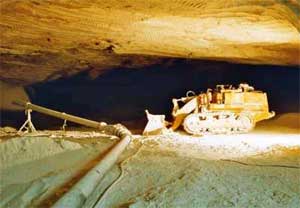
- Backfilling of Chamber # 6 on the 511 m level
Further information on the backfill work at the Asse Mine
- Asse website, "History"
- 5th information meeting of the GSF on 13.05.2004: Günther Kappei, The mining cavities in the south flank are backfilled, the backfill work in the deep workings (for Asse, workings at the 800 m level and below) was started.
Backfilling of the openings below the 800 m level
Preparations for backfilling the mine areas below the former extraction chambers were started in 2003. This work comprised, e. g., the installation of the pipes for pneumatic backfilling in the areas between the 490 m level and the 975 m level. Since December 2004, residual salt from the mine is filled into the openings of the deep workings by means of loaders and compacted by a special vehicle.
By the end of 2006, about 54,000 tons of backfill material was used at the 975 and 950 m levels in accordance with the quality requirements on the salt composition and density. In addition, blind shaft # 1, previously used for ventilation of the deep workings, and the so-called Gelloch # 3 were backfilled with about 4,200 tons of gravel from the diabase quarry Huneberg in the Harz Mountains. For an abutment, another 11,300 tons of salt were filled in at the 925-, 900- and 825 m level.
The cavern at the end of Shaft # 4 was backfilled in 2005 with 13,700 tons of gravel. For this backfill, a drop pipe was installed in Shaft # 2 and stations for transfer of the gravel were set up at surface and underground. After that, the pore space remaining in the gravel was flooded with protective fluid.
For transport and storage of the protective fluid, MgCl2 solution, facilities were installed at surface and underground in 2005. On the surface, a loading facility with forwarding and storage aggregates was set up which is both suitable for tank vehicles on road and rail. Underground, three storage pools were constructed with 500 cubic metres each, equipped with transfer pumps, shaft pipes and a piping network. The latter serves for underground transport and was installed between the 490 m and 975 m level in boreholes and drifts. For wetting the gravel and backfilling the pore space within the salt and gravel backfill, about 10,400 cubic metres MgCl2 solution were pumped into the deep workings.
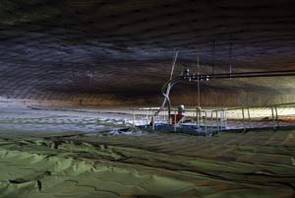
- The storage pools at the 490 m level are covered with a 3 millimetre thick sealing sheeting to reduce evaporation
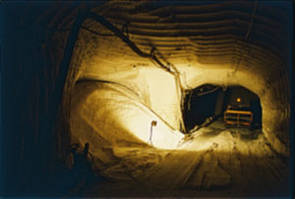
- Backfilled drift on the 975 m level
Relocation of the workshops
After moving, the workshops from the 800 m to the 490 m level, in 2005 the borehole workings moved from the 750 m to the 511 m level.
Facility for building material
For the production of building material – mainly sorel concrete for supporting backfill and barrier structures in the area of disposal chambers –conveying, metering and mixing systems were installed at surface and underground. For the underground part of the building material facility, a 16.500 cubic metre opening was driven on the 700 m level in three shift operation from mid 2004 until the beginning of 2005. Here, the building material facility was erected for the production of the dry mixtures while at the landing of Shaft # 2 at the 850 m level, the mobile mixing and pump facilities were installed for the production of the sorel concrete required for the construction of the flow barriers. In parallel to this, the part of the facility above surface was erected.
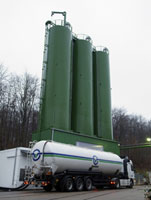
- Silo plant for receipt and pneumatic transfer of the building material into the underground
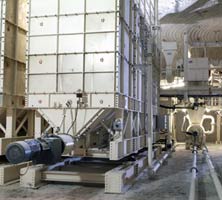
- Building material facility at the 700 m level
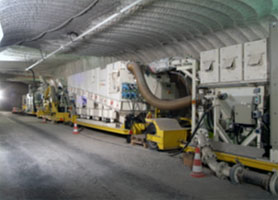
- Mobile mixing and pump facilities at the 750 m level
In August 2005, the whole building material facility started trial operation. The approximately 5,500 cubic metres sorel concrete produced until end of 2006 start-up were filled into the openings no longer required in the western panel on the 750 m level. The trial load operation of the overall facility, a volume flow of 20 cubic metres of sorel concrete per hour, have been produced.
Construction of flow barriers
The task of flow barriers is to provide an effective limitation and controlled flow of potential solution movements in the underground workings. The preparatory mining work for the construction of these technical barriers has been started and a prototype was completed in June 2003.
The preparatory work for the construction of the first barrier has been under way since mid 2005. The revision of the special plan of operations for the construction of the currently planned 65 flow barriers was permitted by the Mining Authority Clausthal-Zellerfeld (now: Landesamt für Bergbau, Energie und Geologie (LBEG)) in February 2006. It concerns a kind of “type approval”, i. e. that the detailed implementation planning of each barrier has to be submitted to the licensing authority before construction. In March 2007 the first flow barrier was established in the so-called “Belgium-Drift” at the 775 m level.
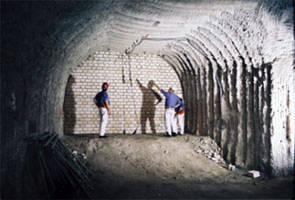
- Prototype PSB A 1 at the 950 m level

- Formwork wall at the 750 m level
Saturated sodium chloride brine
The volume of the collected sodium chloride brine continues to be about 12 cubic-metres per day. Its chemical and physical properties remained unchanged. The solution is no longer added to the backfill material but stored in the brine sump drifts at the 875 m level and in one of the storage pools in Chamber # 3 on the 490 m level. From there, the salt solution is pumped to the surface, transported to a former potash mine by means of tank trucks and used in the underground workings there. From April 2005 to January 2007, about 11,500 cubic metres of saturated sodium chloride brine was given to the K+S Entsorgungs GmbH.
Dismantling, backfilling and sealing of the shafts
The dismantling work in Shaft # 2 and # 4 of the Asse Mine proceeds as scheduled.
- In July 2005, the hoist of Shaft # 2 was shortened to the 750 m level. Since then, men hoisting and shaft transports are only possible down to the 750 m level.
- Withdrawal of steel furniture located in Shaft # 4 between the 925 m and the 750 m level, was successfully terminated in April 2005. This extremely difficult work was performed without any remarkable incidents.
- In December 2005, the Deilmann-Haniel company, contracted to perform the shaft work, started the draw off operation in Shaft # 2. The shaft workings between the 950 m and 800 m level terminated successfully in 2006 without any remarkable incidents.
For the further shaft work, the implementation plannings are to be realised on the basis of the shaft backfill concept developed in 2006. The licences for the different work steps will be applied for at the Landesamt für Bergbau, Energie und Geologie (LBEG) step by step according to progress.
Feeding of protective fluid
Since March 2005, protective fluid has been fed into the backfill material in the area of the deep workings. This measure serves to further minimise the residual pore volume in the backfill and to counteract a decomposition of the explored carnallitite areas due to NaCl solution entering the underground workings.
Ensuring mine safety
Maintenance work in the underground workings at regular intervals ensures the daily safety when working underground. This includes, in particular, controls of areas with rock fall hazard, inspection of cage, hoisting rope and machines as well as maintenance of the transport tracks underground. The same attention is given to the monitoring and maintenance of machines and electro technical equipment. These are, when used underground, subject to a high mechanical stress.
Experimental areas for external researchers
For activities of external researchers, the Asse Mine provides special mine areas which – as is the case for the other areas of the mine – are regularly inspected and maintained.
Railroad connection of the mine
The railroad connection from Wendessen to the mine with a length of 7.25 km also belongs to the area “Mine Operation”. Since 1995, this transport route has been used for the transport of backfill material from Ronnenberg. Within the framework of the closure work, this railroad connection can also be used for major transports of building material to the mine.
Research and development work of external organisations
As long as the activities do not interfere with the preparatory work for closure of the Asse Mine, the GSF Research Centre continues to make its infrastructure available for performance of research and development work of external researchers.
Main users of this offer are the Physikalisch-Technische Bundesanstalt (PTB), the Federal Institute for Geosciences and Natural Resources (BGR), the Gesellschaft für Anlagen- und Reaktorsicherheit mbH (GRS), the German Company for the Construction and Operation of Waste Repositories (DBE) and the Institute of Mining of the Clausthal University of Technology.
Underground laboratory UDO
On behalf of PTB, the underground laboratory for dosimetry and spectrometry UDO 2004 was relocated from the 925 m level to the 490 m level. Also there, the laboratory located in rock salt is characterised by an extremely low background radiation, a low radon concentration in the air and a strongly reduced myon flux density compared to the surface. These prerequisites are unique in Germany.
Electromagnetic reflection measurements
For many years, BGR has been performing electromagnetic reflection measurements in boreholes.
Excavation-disturbed zones
At an experimental location on the 800 m level, GRS analyses exemplary the hydraulically effective excavation-disturbed zone around cavities – such as boreholes and drifts – in salt rocks.
Self-healing salt backfill
At the 574 m level, GRS performs work on petro-chemical and petro-physical research on self healing of residual salt.
New material
At the 800 m level, offsets are made available to the Institute of Mining of the Clausthal University of Technology for testing drift seals composed of anhydrite.
Education
The Asse Research Mine offers apprenticeships as electricians in the special field of operating technology and as industrial mechanic. Click here for further information.